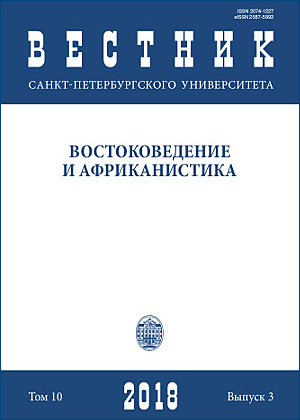The Persian-Tajik lyrics of the poetess Maknuna of Kokand (second half of 18th — first half of 19th centuries)
DOI:
https://doi.org/10.21638/spbu13.2018.306Abstract
The article examines the processes of literary life in Central Asia in the second half of the 18th century and the first half of the 19th century. On the basis of poorly studied original sources the author describes the life, the oeuvre and individual peculiarities of poetic mastership of the outstanding Tajik poetess Maknuna.The poetess’s real name was Mohlar, but she is mostly known under her pen names ‘Maknuna’ (in Persian-Tajik verses), and ‘Nadira’ and ‘Kamila’ (in Uzbek verses). In her collected Persian-Tajik poetry (Divan) Maknuna expressed in poetic language a state of sincere rapture toward her lover.The poets literary legacy is defined by considering the number of ghazals in Persian-Tajik attributed to her and by conducting a qualitative analysis of their subject matter: love lyric, devotion to the (yār) beloved, commentary on affairs of state, ghazals dedicated to death of her beloved husband and governor, poems condemning heaven, criticism of the mendacity of nobles and preachers, ethical observations regarding correct usage of time, poems of loyalty, exultations on autumn in the poet’s homeland, the place of poet in the society, and response-verses (nazira) typical of Persian-Tajik literature. It has been shown that the literary the poet’s mastery lies in the use of traditional poetic acts that amount to responses to classic Persian-Tajik literature. It has also been shown that the masterpiece of the poet is in creating a literal image of the male beloved and that the theme of love is considered to be the main art of Maknuna’s poetics and dominates her oeuvre. In the Persian-Tajik Divan, Maknuna expressed in poetic language a state of sincere rapture toward her lover. The genre-related and thematic, the ideological and artistic essence of Makuna’s Tajik poetical heritage has been examined as part of the history of Persian-Tajik literature between 1750–1850.
Keywords:
Maknuna, Mohlar, Nadira, Kamila, poetess, Central Asia, Kokand, Persian-Tajik poetry, divan
Downloads
References
Downloads
Published
How to Cite
Issue
Section
License
Articles of "Vestnik of Saint Petersburg University. Asian and African Studies" are open access distributed under the terms of the License Agreement with Saint Petersburg State University, which permits to the authors unrestricted distribution and self-archiving free of charge.





